Upside Down Horseshoe: What Does It Symbolize?
The upside-down horseshoe symbol holds diverse meanings across various cultures and eras. Historically, it symbolized the moon and protection in ancient Greece.
In Western cultures today, it's often linked to bad luck, contrasting with some Eastern European traditions where it still represents protection. In Latin America, the symbol is associated with fertility and prosperity.
Modern superstitions regard it as an emblem of misfortune in contexts like Irish folklore. Additionally, its use in digital communication often denotes sarcasm or irony.
Understanding the complex interplay of these interpretations reveals deeper insights into this potent symbol's significance in our world.

Key Takeaways
- Upside down horseshoes are considered unlucky in Western cultures, believed to spill out the luck they contain.
- In Irish folklore, an upside down horseshoe symbolizes bad luck and misfortune.
- Some Eastern European traditions view upside down horseshoes as a symbol of protection and warding off evil.
- The symbol's meaning varies significantly by region, reflecting diverse cultural beliefs and interpretations.
- Modern superstitions blend historical connotations with contemporary perspectives, making the upside down horseshoe a complex emblem.
Historical Origins
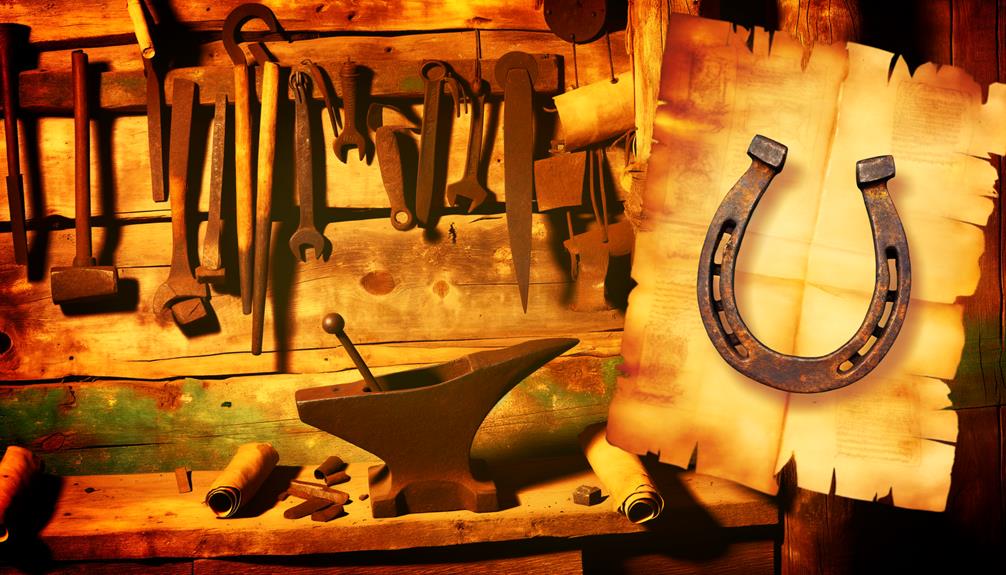
The historical origins of the upside down horseshoe symbol can be traced back to various ancient cultures where it was imbued with distinct meanings and superstitions.
In ancient Greece, horseshoes were considered talismans due to their crescent shape, symbolizing the moon and invoking protective deities.
The Romans, too, saw the horseshoe as a safeguard against evil, often nailing it upside down to ward off malevolent spirits.
In medieval Europe, the horseshoe's iron composition was believed to repel faeries and witches. During the Middle Ages, blacksmiths were perceived as possessing magical abilities, further enhancing the horseshoe's mystical reputation.
These historical contexts laid the foundation for the diverse interpretations and beliefs surrounding the upside down horseshoe that persist in various forms today.
Cultural Significance
The cultural significance of the upside-down horseshoe is multifaceted, drawing from historical context and beliefs that vary across regions.
In some cultures, it is viewed as an emblem of misfortune, while in others, it is interpreted as a symbol of protection and luck when displayed in specific orientations.
Examining modern-day cultural usage reveals an evolving symbolism that often blends traditional interpretations with contemporary meanings.
Historical Context and Beliefs
Throughout various cultures and historical periods, the upside-down horseshoe has held diverse symbolic meanings, often reflecting the prevailing beliefs and superstitions of the time.
In ancient Greece and Rome, horseshoes, including their orientation, were linked to the god of blacksmiths, Hephaestus/Vulcan, symbolizing craftsmanship and protection.
Medieval Europe saw an upside-down horseshoe as a harbinger of misfortune, believed to spill out its luck. Contrarily, some Celtic traditions viewed it as a vessel to catch and hold luck.
The symbol's interpretation was often tied to the society's worldview and spiritual inclinations, illustrating how a single emblem could embody contrasting connotations across different eras and locales. This variability underscores the rich tapestry of human belief systems and their evolution.
Regional Symbolic Interpretations
Examining the upside-down horseshoe through the lens of regional symbolic interpretations reveals a complex tapestry of cultural significance that varies markedly from one locale to another. In Western cultures, the upside-down horseshoe often symbolizes bad luck, believed to spill out its fortune. Conversely, in some Eastern European traditions, the same symbol can represent protection, capturing evil spirits within its arc. Latin American interpretations add another layer, associating it with fertility and agricultural prosperity.
| Region | Symbolism | Cultural Context |
|---|---|---|
| Western Cultures | Bad luck | Fortune spilling out |
| Eastern Europe | Protection | Capturing evil spirits |
| Latin America | Fertility and prosperity | Agricultural and spiritual beliefs |
This diverse symbolism underscores how regional contexts shape the horseshoe's meaning.
Modern-Day Cultural Usage
In contemporary culture, the upside-down horseshoe symbol has evolved to encompass a wide range of meanings, reflecting both global interconnectedness and localized traditions. While historically associated with bad luck, modern interpretations have diversified.
In some communities, an upside-down horseshoe is seen as a vessel to pour out blessings or protection. This reinterpretation highlights how symbols can transform through cultural exchange and reinterpretation.
In digital communication, the emoji of an upside-down horseshoe is sometimes used to denote sarcasm or irony, further showcasing its adaptability.
Additionally, in fashion and interior design, the symbol is often employed for its aesthetic appeal, detached from any traditional connotations.
Hence, the upside-down horseshoe continues to be a dynamic element in contemporary symbolism.
Symbolism in Folklore

Rooted deeply in various cultural narratives, the upside-down horseshoe symbol often represents both protection against and the warding off of malevolent forces in folklore.
In many European traditions, placing a horseshoe upside down above a door was believed to catch evil spirits, preventing them from entering the home. This practice underscores a broader folkloric belief in apotropaic symbols—objects thought to have the power to avert evil influences.
Additionally, in some cultures, the upside-down horseshoe was considered a vessel for capturing good luck, ensuring it did not spill out. These interpretations reflect a rich tapestry of symbolic meanings, where the orientation of a seemingly ordinary object could influence one's fortune, safety, and overall well-being in the communal psyche.
Religious Interpretations
Religious interpretations of the upside-down horseshoe symbol often stem from ancient spiritual symbols that convey profound meanings.
Historically, this orientation has been associated with divine protection, believed to channel celestial energies and safeguard individuals from harm.
Cultural variations further illustrate how different societies imbue the upside-down horseshoe with unique spiritual significance, reflecting diverse theological perspectives and practices.
Ancient Spiritual Symbols
Throughout history, the upside down horseshoe symbol has held diverse spiritual and religious connotations, often representing protection, luck, and the cyclical nature of life and the cosmos in various ancient cultures.
In ancient Mesopotamia, the symbol was associated with the goddess Ishtar, embodying fertility and celestial power.
Similarly, in Greek and Roman traditions, the crescent shape, reminiscent of an inverted horseshoe, symbolized lunar deities and the regeneration of life.
The Celts also revered this form, linking it to their moon goddess, indicative of the eternal cycle of birth and rebirth.
Such interpretations highlight the universal human quest to understand and harness the forces of nature, illustrating the profound spiritual resonance of the upside down horseshoe across different epochs.
Divine Protection Significance
The upside down horseshoe symbol's association with divine protection is deeply entrenched in numerous religious traditions, where it is often regarded as a powerful talisman against evil and misfortune.
In Christianity, the horseshoe, when inverted, is believed to catch and trap negative energies, preventing them from entering a sacred space.
Similarly, in Islamic culture, the symbol is often invoked for safeguarding homes and families, reflecting a common belief in divine intervention.
Ancient Greek and Roman societies also revered the horseshoe as a protective amulet, attributing its shape to the crescent moon, a symbol of various deities.
This enduring motif underscores a universal yearning for divine guardianship, transcending cultural and temporal boundaries in its quest for spiritual security.
Cultural Symbolic Variations
Interpretations of the upside down horseshoe symbol vary greatly across different cultures, each infusing it with unique spiritual and religious significance. In Christianity, an upside down horseshoe can symbolize the outpouring of blessings, signifying divine favor.
In contrast, some pagan traditions see it as a protective emblem that wards off evil spirits when hung over doorways.
Here are four notable cultural interpretations:
- Christianity: Symbolizes blessings and divine favor.
- Paganism: Acts as a protective charm against malevolent forces.
- Irish Folklore: Considered unlucky, as it suggests that luck is 'spilling out.'
- Italian Traditions: Embodies fertility and prosperity when positioned upside down.
Each interpretation reflects deep-seated spiritual beliefs, demonstrating the symbol's rich cultural tapestry.
Modern Superstitions
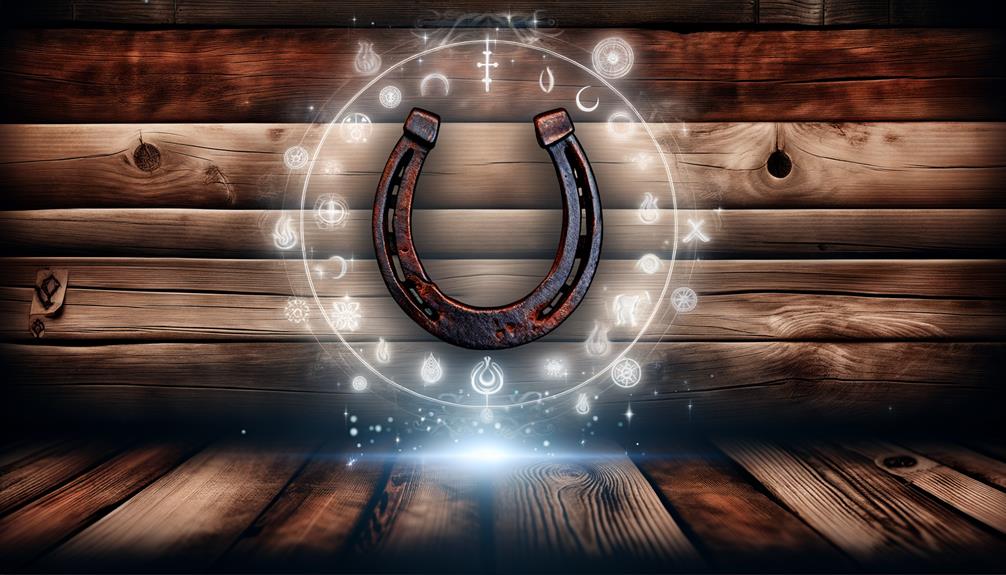
In contemporary society, the upside-down horseshoe has become a focal point of various superstitions, symbolizing themes that range from bad luck to protection against malevolent forces.
Traditionally, a horseshoe hung with its ends pointing downward is thought to let the luck 'drain out,' thereby inviting misfortune. However, some modern interpretations counter this view, suggesting that it forms a protective barrier, warding off negative energies.
This duality reflects broader societal shifts towards reinterpreting old symbols through contemporary lenses. It underscores a collective consciousness that is increasingly blending historical beliefs with new-age spiritualism.
Consequently, the upside-down horseshoe serves as a complex emblem in modern superstition, embodying a nuanced interplay between tradition and evolving cultural perspectives.
Variations Across Cultures
Examining the symbolism of the upside-down horseshoe through a cultural lens reveals diverse interpretations that reflect each society's unique historical context and spiritual beliefs.
In Western cultures, the upside-down horseshoe is often seen as a sign of bad luck, symbolizing the loss of protective energies.
Meanwhile, in some Eastern traditions, it is perceived as a vessel that pours out blessings and good fortune.
Consider the following cultural variations:
- Irish Folklore: An upright horseshoe is seen as a good luck charm, with an upside-down one thought to spill luck away.
- Spanish Culture: Often hung upside down to make sure that luck is constantly flowing.
- Italian Traditions: Represents protection against evil when displayed upside down.
- Indian Practices: Utilized in rituals for warding off negative energies.
Use in Art and Decor
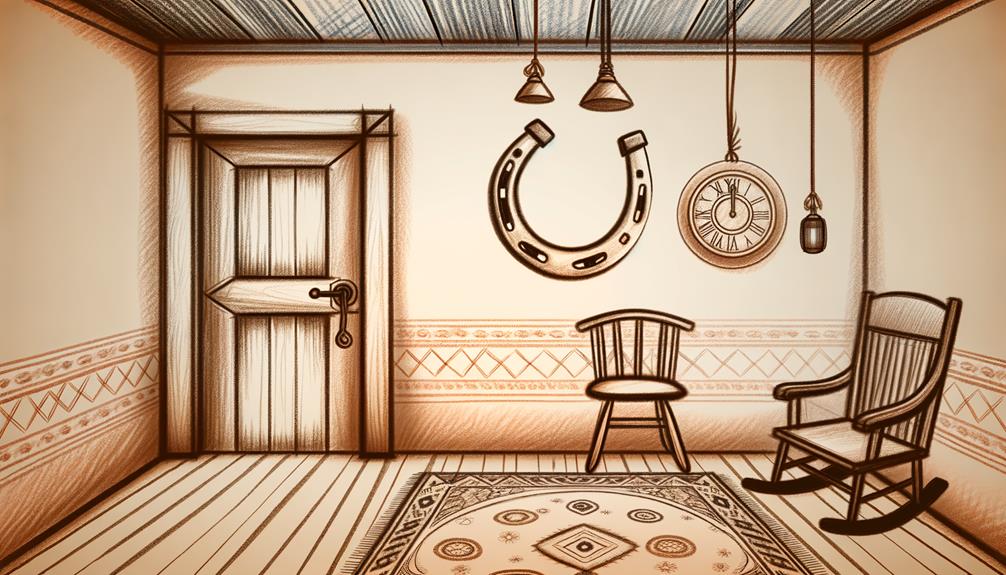
The cultural significance of the upside-down horseshoe extends beyond tradition and belief, manifesting prominently in various forms of art and decor where its interpretation continues to inspire and influence aesthetic choices.
Artists and designers often incorporate this symbol to evoke themes of protection, luck, and mysticism. In interior decor, upside-down horseshoes are frequently used as wall hangings, sculptures, and motifs in furniture design. Their presence is not merely ornamental but also serves as a conversation piece, blending historical connotations with modern interpretations.
This duality allows the symbol to transcend its folkloric roots, becoming a versatile element in both classical and contemporary artistic expressions. Therefore, the upside-down horseshoe remains a potent emblem in the visual and decorative arts landscape.
Psychological Impact
Understanding the psychological impact of the upside-down horseshoe symbol requires a thorough examination of its association with cultural beliefs and personal perceptions of luck and protection. Individuals often respond to symbols based on deeply ingrained societal narratives and personal experiences.
The upside-down horseshoe, traditionally seen as unlucky, can evoke a range of psychological responses:
- Anxiety: Fear of bad luck may heighten stress and worry.
- Comfort: Some cultures interpret it as a protective talisman, offering reassurance.
- Curiosity: Its unique orientation can provoke interest and deeper exploration.
- Skepticism: Rational individuals may dismiss its significance, viewing it as mere superstition.
These varied reactions underscore the complex interplay between symbolism and human psychology.
Scientific Perspectives
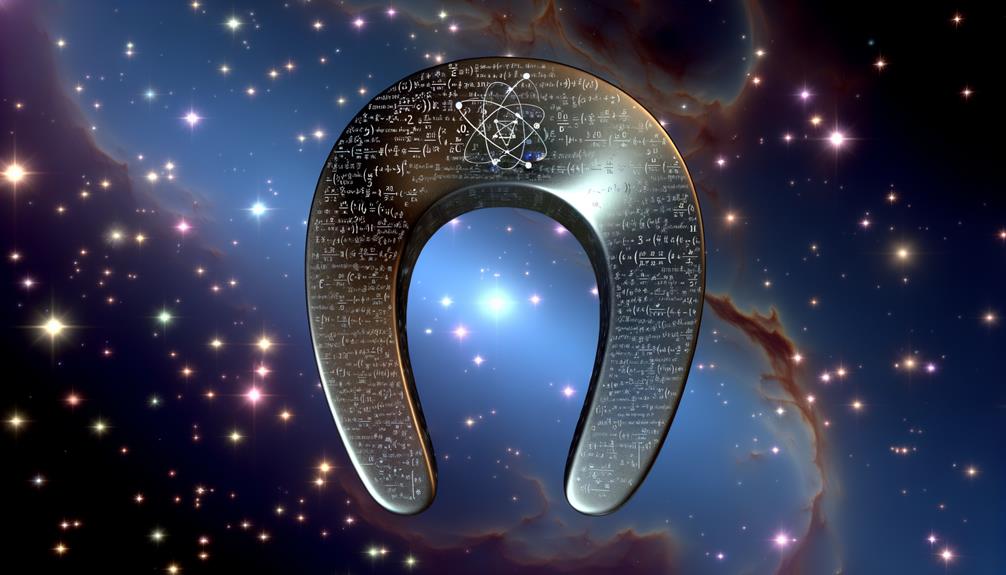
In scientific contexts, the upside-down horseshoe symbol, often represented as '∩', holds significant mathematical and physical interpretations. Mathematically, it is used to denote the intersection of sets, a fundamental concept in set theory that finds applications across various branches of mathematics, including probability and logic.
Physically, the symbol can be seen in electromagnetism to represent magnetic flux, illustrating its importance in understanding magnetic fields and their interactions.
Mathematical Significance
Within mathematical discourse, the upside-down horseshoe symbol, known as the logical NAND operator, holds significant importance in the domains of propositional logic and Boolean algebra.
This operator is fundamental due to its unique properties and applications:
- Universality: The NAND operator can be used to construct any other logical operation, making it a cornerstone in digital circuit design.
- Expression Simplification: It allows for the simplification of complex Boolean expressions, streamlining logical analyses.
- Fault Detection: In digital systems, NAND gates are instrumental in error detection and correction algorithms.
- Logical Completeness: It plays a pivotal role in proving the completeness of logical systems, ensuring all possible logical functions can be represented.
These attributes underscore the symbol's pervasive utility in mathematical and computational contexts.
Physical Interpretations
From a scientific perspective, the upside-down horseshoe symbol often appears within the field of physics, particularly in discussions about potential energy surfaces and quantum mechanics, where it represents specific forms of energy interactions and constraints. In quantum mechanics, this symbol is typically used to denote various quantum states and their respective potential energy levels.
| Symbol | Interpretation |
|---|---|
| ∇²ψ | Laplacian of the wave function |
| V(x) | Potential energy as a function of position |
| E | Energy eigenvalue |
| ℏ | Reduced Planck's constant |
| Ψ | Wave function |
Understanding these symbols helps physicists describe particle behaviors and constraints within potential fields. The upside-down horseshoe symbol, consequently, is integral in formulating the Schrödinger equation and analyzing the quantum states of systems.
Contemporary Uses
The upside-down horseshoe symbol, often laden with historical connotations, has found diverse applications in contemporary culture, spanning from digital communication to modern art. Its presence is seen in various contexts:
- Emojis and Text Symbols: Used in digital messaging to denote luck or its absence.
- Graphic Design: Featured in logos and branding to evoke a sense of unconventionality or modernity.
- Fashion: Incorporated in jewelry and clothing as a statement piece reflecting unique style or belief.
- Home Decor: Displayed in interior design to symbolize protection or as a conversation starter.
These contemporary uses underscore the symbol's versatility and adaptability, reflecting how ancient symbols can seamlessly integrate into modern paradigms, enriching cultural and aesthetic expressions.
Personal Stories and Beliefs
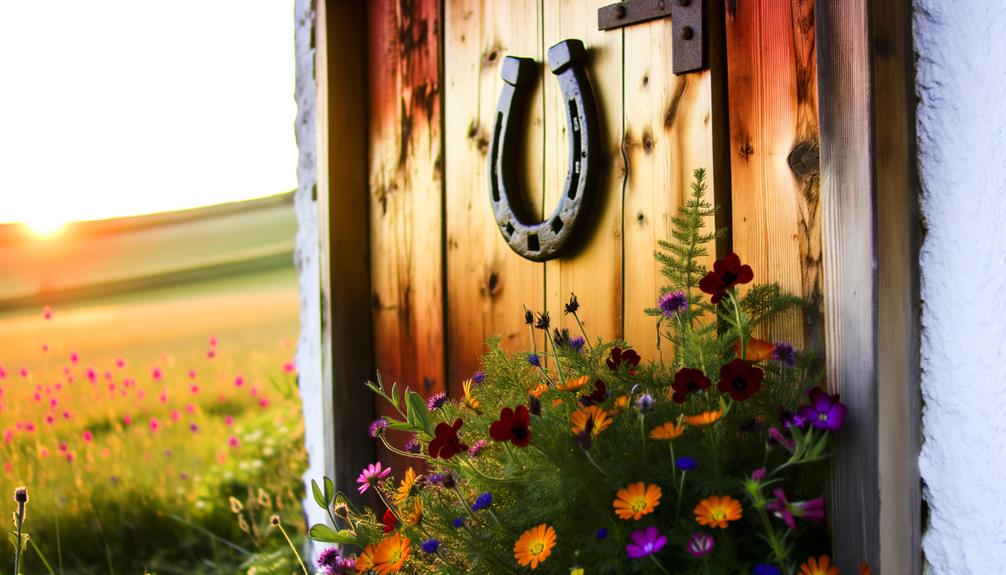
Many individuals recount personal stories and beliefs associated with the upside-down horseshoe symbol, revealing a rich tapestry of cultural interpretations and emotional connections.
In some narratives, the inverted horseshoe is seen as a conduit for misfortune, a stark contrast to its upright counterpart believed to capture and hold luck. Conversely, others share tales of the upside-down horseshoe acting as a protective charm, dispelling negative energy and safeguarding spaces.
Personal anecdotes often highlight the symbol's significance in family traditions, where its orientation is carefully chosen based on generational wisdom. Such varied beliefs underscore the symbol's embeddedness in cultural contexts, illustrating how personal experiences shape and redefine its meaning across different communities and time periods.
Conclusion
The upside down horseshoe symbol, steeped in historical origins and cultural significance, embodies a rich tapestry of meanings, from folklore to modern superstitions. Examined through religious, psychological, and scientific lenses, it reveals complex layers of interpretation.
As in the adage, 'One man's trash is another man's treasure,' this symbol demonstrates how context and belief shape its perceived value. Contemporary uses and personal stories further illustrate its enduring impact on human consciousness and societal norms.





